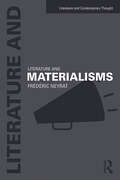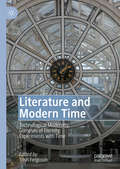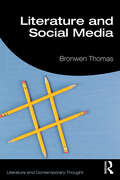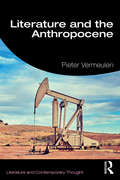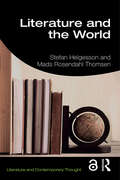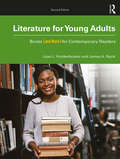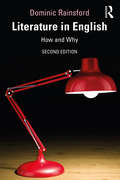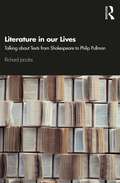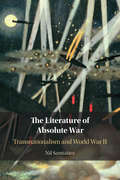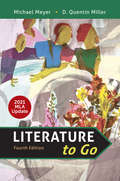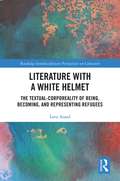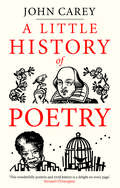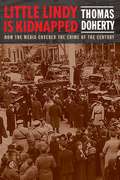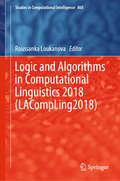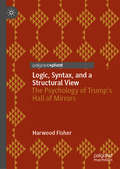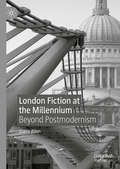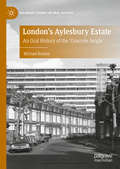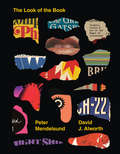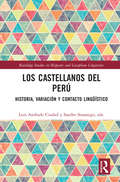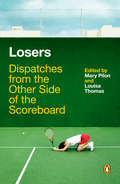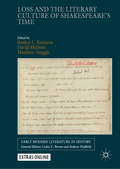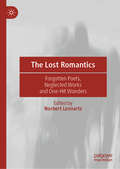- Table View
- List View
Literature and Materialisms (Literature and Contemporary Thought)
by Frederic NeyratLiterature and Materialisms sheds light on the current new wave of materialisms and assesses the impact on literary theory and criticism. It maps the similarities and differences between speculative realism, object-oriented philosophy, and vitalism. A genealogy of materialisms, vitalisms, empiricisms, and realist approaches - from Heraclitus to Badiou, including Lucretius, Spinoza, Marx, Althusser, Barad, Spivak, Deleuze, Bennett, Harman, and other contemporary thinkers - puts these new trends into perspective. This book investigates the relations between literature – from Marquis de Sade to objectivist poetry - and materialism and analyses the material aspects of literature, its structure and texture, its commodification and its capacity to resist market imperatives. It explores how literary style might be understood as a mediation between the ‘immaterial’ and the concrete features of a text. This volume provides students and academics with an accessible overview of the study of literature and materialism.
Literature and Modern Time: Technological Modernity; Glimpses of Eternity; Experiments with Time
by Trish FergusonLiterature and Modern Time is a collection of essays that explore literature in the context of a wave of challenges to linear conceptions of time introduced by thinkers such as Bergson, Einstein, McTaggart, Freud and Nietzsche. These challenges were not uniform in character. The volume will demonstrate that literature of the era under scrutiny was not simply reacting to new theories of time—in some cases it is actually inspiring and anticipating them. Thus Literature and Modern Time promises to offer a genuine dialogue between literature and time theory and in doing so will uncover and examine influences and connections— sometimes unexpected—between philosophers and writers of the era. It will examine literary attempts to transcend and escape time and also challenge rupture-based accounts of modernist time by demonstrating that literary texts commonly associated with brokenness, decline or stasis, also, at the same time, maintain faith in healing, renewal and mobility.This collection contains interdisciplinary research of the quite highest kind - to see so many different kinds of time - narrative, historical, mechanical, subjective, non-linear time, myth and nostalgia - as well as time/space discussed here is very stimulating indeed.Professor Simon James
Literature and Social Media (Literature and Contemporary Thought)
by Bronwen ThomasFrom Instapoetry to BookTube, contemporary literary cultures and practices are increasingly intertwined with social media. In this lively and wide-ranging study, Bronwen Thomas explores how social media provides new ways of connecting with and rediscovering established literary works and authors while also facilitating the emergence of unique and distinctive forms of creative expression. The book takes a 360˚ approach to the subject, combining analysis of current forms and practices with an examination of how social media fosters ongoing collaborative discourse amongst both informal and formal literary networks, and demonstrating how the participatory practices of social media have the potential to radically transform how literature is produced, shared and circulated. The first study of its kind to focus specifically on social media, Literature and Social Media provides a timely and engaging account of the state of the art, while interrogating the rhetoric that so often accompanies discussion of the ‘new’ in this context.
Literature and the Anthropocene (Literature and Contemporary Thought)
by Pieter VermeulenThe Anthropocene has fundamentally changed the way we think about our relation to nonhuman life and to the planet. This book is the first to critically survey how the Anthropocene is enriching the study of literature and inspiring contemporary poetry and fiction. Engaging with topics such as genre, life, extinction, memory, infrastructure, energy, and the future, the book makes a compelling case for literature’s unique contribution to contemporary environmental thought. It pays attention to literature’s imaginative and narrative resources, and also to its appeal to the emotions and its relation to the material world. As the Anthropocene enjoins us to read the signals the planet is sending and to ponder the traces we leave on the Earth, it is also, this book argues, a literary problem. Literature and the Anthropocene maps key debates and introduces the often difficult vocabulary for capturing the entanglement of human and nonhuman lives in an insightful way. Alternating between accessible discussions of prominent theories and concise readings of major works of Anthropocene literature, the book serves as an indispensable guide to this exciting new subfield for academics and students of literature and the environmental humanities.
Literature and the World (Literature and Contemporary Thought)
by Stefan Helgesson Mads Rosendahl ThomsenLiterature and the World presents a broad and multifaceted introduction to world literature and globalization. The book provides a brief background and history of the field followed by a wide spectrum of exemplary readings and case studies from around the world. Amongst other aspects of World Literature, the authors look at: New approaches to digital humanities and world literature Ecologies of world literature Rethinking geography in a globalized world Translation Race and political economy Offering state of the art debates on world literature, this volume is a superb introduction to the field. Its critically thoughtful approach makes this the ideal guide for anyone approaching World Literature.
Literature for Young Adults: Books (and More) for Contemporary Readers
by Joan L. Knickerbocker James A. RycikNow in its second edition, this book explores a great variety of genres and formats of young adult literature while placing special emphasis on contemporary works with nontraditional themes, protagonists, and literary conventions that are well suited to young adult readers. It looks at the ways in which contemporary readers can access literature and share the works they're reading, and it shows teachers the resources that are available, especially online, for choosing and using good literature in the classroom and for recommending books for their students’ personal reading. In addition to traditional genre chapters, this book includes chapters on literary nonfiction; poetry, short stories, and drama; and film. Graphic novels, diversity issues, and uses of technology are also included throughout the text. The book's discussion of literary language—including traditional elements as well as metafictive terms—enables readers to share in a literary conversation with their peers (and others) when communicating about books. This book is an essential resource for preservice educators to help young adults understand and appreciate the excellent literature that is available to them. New to the second edition: New popular authors, books, and movies with a greater focus on diversity of literature Updated coverage of new trends, such as metafiction, a renewed focus on nonfiction, and retellings of canonical works Increased attention to graphic novels and multimodal texts throughout the book eResources with downloadable materials, including book lists, awards lists, and Focus Questions
Literature in English: How and Why
by Dominic RainsfordLiterature in English: How and Why is an accessible guide for students. It deals with the fundamental concepts of literary form and genre; the history of English-language literature from the medieval period to the present; relations between the study of literature and other disciplines; literary theory; researching a topic; and writing a paper. The new edition contains a brand new chapter which takes literary theory to another level, using it to link literature to the issues that concern us most, whether in our own lives or in the UN’s Sustainable Development Goals. The book has also been fully updated throughout, with significant additions to the introduction and further reading sections. Overall, Literature in English: • Grounds the study of literature throughout by referencing a selection of well-known novels, plays and poems • Examines the central questions that readers ask when confronting literary texts, and shows how these make literary theory meaningful and necessary • Links British, American and postcolonial literature into a coherent whole • Discusses film as literature and provides the basic conceptual tools needed to study film within a literature-course framework • Places particular emphasis on interdisciplinarity by examining the connections between the study of literature and other disciplines • Links literary theory to current global challenges, placing special emphasis on new and evolving approaches such as ecocriticism, new materialism, and the spatial turn • Provides extensive guidance on further reading. Written in a clear and engaging style, this is an essential guide for literature students around the world.
Literature in our Lives: Talking About Texts from Shakespeare to Philip Pullman
by Richard JacobsThis book recreates in written form seventeen of the most popular, frankly personal and engaging lectures on literature given by the award-winning teacher Richard Jacobs, who has been working with students for over forty years. This is a book written for students, whether starting their studies or more experienced, and also for all lovers of literature. At its heart is the conviction that reading, thinking about, and writing or talking about literature involves us all personally: texts talk to us intimately and urgently, inviting us to talk back, intervening in and changing our lives. These lectures discuss, in an open but richly informed way, a wide range of texts that are regularly studied and enjoyed. They model what it means to be excited about reading and studying literature, and how the study of literature can be life-changing - perhaps even with the effect of changing the lives of readers of this eloquent and remarkable book.
The Literature of Absolute War: Transnationalism and World War II
by Nil SantiáñezThis book explores for the first time the literature of absolute war in connection to World War II. From a transnational and comparative standpoint, it addresses a set of theoretical, historical, and literary questions, shedding new light on the nature of absolute war, the literature on the world war of 1939–45, and modern war writing in general. It determines the main features of the language of absolute war, and how it gravitates around fundamental semantic clusters, such as the horror, terror, and the specter. The Literature of Absolute War studies the variegated responses given by literary authors to the extreme and seemingly unsolvable challenges posed by absolute war to epistemology, ethics, and language. It also delves into the different poetics that articulate the writing on absolute war, placing special emphasis on four literary practices: traditional realism, traumatic realism, the fantastic, and catastrophic modernism.
Literature to Go with 2021 MLA Update
by Michael Meyer D. Quentin MillerThis ebook has been updated to provide you with the latest guidance on documenting sources in MLA style and follows the guidelines set forth in the MLA Handbook, 9th edition (April 2021).Drawn from our best-selling anthology The Compact Bedford Introduction to Literature, Literature to Go is a brief and inexpensive collection of stories, poems, and plays accompanied by thorough critical reading and writing support.
Literature with A White Helmet: The Textual-Corporeality of Being, Becoming, and Representing Refugees (Routledge Interdisciplinary Perspectives on Literature)
by Lava AsaadLiterature with A White Helmet explores issues of refugee writers, contemporary works of fiction and nonfiction on the refugee’s body and experience, the biopolitics of refugees, and disputes over the ethicality of representing refugees by writers and human rights activists. The book relies on a broad selection of texts by authors who, in one way or another, have experienced displacement, witnessed it, imagined it, or co-written about it.
Little Bird and the Bath (Into Reading, Level D #57)
by Eve Browne Melissa WebbNIMAC-sourced textbook
A Little History of Poetry (Little Histories)
by John CareyA vital, engaging, and hugely enjoyable guide to poetry, from ancient times to the present, by one of our greatest champions of literature What is poetry? If music is sound organized in a particular way, poetry is a way of organizing language. It is language made special so that it will be remembered and valued. It does not always work—over the centuries countless thousands of poems have been forgotten. This little history is about some that have not. John Carey tells the stories behind the world&’s greatest poems, from the oldest surviving one written nearly four thousand years ago to those being written today. Carey looks at poets whose works shape our views of the world, such as Dante, Chaucer, Shakespeare, Whitman, and Yeats. He also looks at more recent poets, like Derek Walcott, Marianne Moore, and Maya Angelou, who have started to question what makes a poem "great" in the first place. This little history shines a light on the richness and variation of the world&’s poems—and the elusive quality that makes them all the more enticing.
Little Lindy Is Kidnapped: How the Media Covered the Crime of the Century
by Thomas DohertyThe biggest crime story in American history began on the night of March 1, 1932, when the twenty-month-old son of Charles and Anne Lindbergh was snatched from his crib in Hopewell, New Jersey. The news shocked a nation enthralled with the aviator, the first person to fly solo nonstop across the Atlantic. American law enforcement marshalled all its resources to return “Little Lindy” to the arms of his parents—and perhaps even more energized were the legions of journalists catering to a public whose appetite for Lindbergh news was insatiable.In Little Lindy Is Kidnapped, Thomas Doherty offers a lively and comprehensive cultural history of the media coverage of the abduction and its aftermath. Beginning with Lindbergh’s ascent to fame and proceeding through the trial and execution of the accused kidnapper, Doherty traces how newspapers, radio, and newsreels reported on what was dubbed the “crime of the century.” He casts the affair as a transformative moment for American journalism, analyzing how the case presented new challenges and opportunities for each branch of the media in the days before the rise of television. Coverage of the Lindbergh story, Doherty reveals, set the template for the way the media would treat breaking news ever after. An engrossing account of an endlessly fascinating case, Little Lindy Is Kidnapped sheds new light on an enduring quality of journalism ever since: the media’s eye on a crucial part of the story—itself.
Logic and Algorithms in Computational Linguistics 2018 (Studies in Computational Intelligence #860)
by Roussanka LoukanovaThis book focuses mainly on logical approaches to computational linguistics, but also discusses integrations with other approaches, presenting both classic and newly emerging theories and applications.Decades of research on theoretical work and practical applications have demonstrated that computational linguistics is a distinctively interdisciplinary area. There is convincing evidence that computational approaches to linguistics can benefit from research on the nature of human language, including from the perspective of its evolution.This book addresses various topics in computational theories of human language, covering grammar, syntax, and semantics. The common thread running through the research presented is the role of computer science, mathematical logic and other subjects of mathematics in computational linguistics and natural language processing (NLP). Promoting intelligent approaches to artificial intelligence (AI) and NLP, the book is intended for researchers and graduate students in the field.
Logic, Syntax, and a Structural View: The Psychology of Trump's Hall of Mirrors
by Harwood FisherThis book presents a new structural approach to the psychology of the person, inspired by Kenneth Colby’s computer-generated simulation, PARRY. The simulation was of a paranoid psychological state, represented in forms of the person's logic and syntax, as these would be evidenced in personal communication. Harwood Fisher uses a Structural View to highlight similarities in the logical form of the linguistic representations of Donald Trump, his avid followers (“Trumpers”), and the paranoid—referred to as “The Trio.” He demonstrates how the Structural View forms a series of logical and schematic patterns, similar to the way that content analysis can bring forth associations meanings, and concepts held in the text. Such comparisons, Fisher argues, can be used to shed light on contingencies for presenting, representing, and judging truth. Specifically, Fisher posits that the major syntactic and logical patterns that were used to produce the computer-generated “paranoid” responses in Colby’s project can be used to analyze Donald Trump’s rhetoric and his followers’ reactions to it. Ultimately, Fisher offers a new kind of structural approach for the philosophy of psychology. This novel work will appeal to students and scholars of social and cognitive psychology, psychology of personality, psychiatric classification, psycholinguistics, rhetoric, and computer science.
London Fiction at the Millennium: Beyond Postmodernism
by Claire AllenThis book analyses London fiction at the millennium, reading it in relation to an exploration of a theoretical positioning beyond the postmodern. It explores how a selection of novels can be considered as “second-wave” or “post-postmodern” in light of their borrowing more from mainstream and classical genres as opposed to formally experimental avant-garde techniques. It considers how writers utilise the cultural capital of London in a process of relocating marginalized, subjugated or under-represented voices. The millennium provides an apt symbolic opportunity to reflect on British fiction and to consider the direction in which contemporary authors are moving. As such, key novels by Martin Amis, Bella Bathurst, Bernardine Evaristo, Mark Haddon, Nick Hornby, Hanif Kureishi, Andrea Levy, Gautam Malkani, Timothy Mo, Will Self, Ali Smith, Zadie Smith, Rupert Thomson, and Sarah Waters are used to explore writing beyond the postmodern.‘In this significant and welcome contribution to the field, Allen provides us with a sophisticated, detailed, and rigorous study of the move in contemporary fiction beyond postmodernism as exemplified by London fiction.’—Nick Hubble, Brunel University London, UK
London's Aylesbury Estate: An Oral History of the 'Concrete Jungle' (Palgrave Studies in Oral History)
by Michael RomynThis book looks beyond the Aylesbury’s public face by examining its rise and fall from the perspective of those who knew it, based largely on the oral testimony and memoir of residents and former residents, youth and community workers, borough Councillors, officials, police officers and architects. What emerges is not a simple story of definitive failures, but one of texture and complexity, struggle and accord, family and friends, and of rapidly changing circumstances. The study spans the years 1967 to 2010 – from the estate’s ambitious inception until the first of its blocks were pulled down. It is a period rarely dealt with by historians of council housing, who have typically confined themselves to the years before or after the 1979 watershed. As such, it demonstrates how shifts in housing policy, and broader political, economic and social developments, came to bear on a working-class community – for good and, more especially, for ill.
The Look of the Book: Jackets, Covers, and Art at the Edges of Literature
by Peter Mendelsund David J. AlworthWhy do some book covers instantly grab your attention, while others never get a second glance? Fusing word and image, as well as design thinking and literary criticism, this captivating investigation goes behind the scenes of the cover design process to answer this question and more.As the outward face of the text, the book cover makes an all-important first impression. The Look of the Book examines art at the edges of literature through notable covers and the stories behind them, galleries of the many different jackets of bestselling books, an overview of book cover trends throughout history, and insights from dozens of literary and design luminaries. Co-authored by celebrated designer and creative director Peter Mendelsund and scholar David Alworth, this fascinating collaboration, featuring hundreds of covers, challenges our notions of what a book cover can and should be.
Los castellanos del Perú: historia, variación y contacto lingüístico (Routledge Studies in Hispanic and Lusophone Linguistics)
by Luis Andrade Ciudad y Sandro Sessarego, eds.Este libro reúne contribuciones de destacados investigadores de la lingüística hispánica para ofrecer un panorama integral de los castellanos del Perú, incluidos algunos que han sido tradicionalmente objeto de discriminación, como el castellano andino, el amazónico y el afroperuano. Los capítulos se concentran en diferentes variedades habladas en el Perú desde distintos enfoques teóricos y metodológicos, atendiendo a su formación, su contexto social e histórico y los fenómenos de contacto que las caracterizan. De este modo, aunque el volumen tiene un foco regional muy específico, los problemas que aborda son de interés y relevancia para el estudio de otras variedades del español, para el tratamiento de otros problemas derivados del contacto lingüístico y para la dialectología e historia de los castellanos latinoamericanos en general. Escrito en castellano, este volumen será de interés para estudiantes graduados en lingüística hispánica e investigadores dedicados a la dialectología, la sociolingüística y la lingüística del contacto.
Losers: Dispatches from the Other Side of the Scoreboard
by Louisa Thomas Mary Pilon&“It's easy to do anything in victory. It&’s in defeat that a man reveals himself.&” —Floyd Patterson Twenty-two notable writers—including Bob Sullivan, Abby Ellin, Mike Pesca, Sir Arthur Conan Doyle, Louisa Hall, and Gay Talese—examine the untold stories of the losers, and in doing so reveal something raw and significant about what it means to be humanThe locker rooms of winning teams are crowded with coaches, family, and fans. Reporters flock to the athletes, brimming with victory and celebration, to ask, How does it feel? In contrast, the locker rooms of the losing teams are quiet and awkward, and reporters tend to leave quickly, reluctant to linger too long around loss.But, as sports journalists Mary Pilon and Louisa Thomas argue, losing is not a phenomenon to be overlooked, and in Losers, they have called upon novelists, reporters, and athletes to consider what it means to lose. From the Olympic gymnast who was forced to surrender her spot to another teammate, to the legacy of Bill Buckner's tenth-inning error in the 1986 World Series, to LeBron James's losing record in the NBA Finals, these essays range from humorous to somber, but all are united by their focus on defeat. Interweaving fourteen completely new and unpublished pieces alongside beloved classics of the genre, Losers turns the art of sports writing on its head and proves that there is inspiration to be found in stories of risk, resilience, and getting up after you've been knocked down.
Loss and the Literary Culture of Shakespeare’s Time (Early Modern Literature in History)
by Matthew Steggle Roslyn L. Knutson David McInnisAs early modernists with an interest in the literary culture of Shakespeare’s time, we work in a field that contains many significant losses: of texts, of contextual information, of other forms of cultural activity. No account of early modern literary culture is complete without acknowledgment of these lacunae, and although lost drama has become a topic of increasing interest in Shakespeare studies, it is important to recognize that loss is not restricted to play-texts alone. Loss and the Literary Culture of Shakespeare’s Time broadens the scope of the scholarly conversation about loss beyond drama and beyond London. It aims to develop further models and techniques for thinking about lost plays, but also of other kinds of lost early modern works, and even lost persons associated with literary and theatrical circles. Chapters examine textual corruption, oral preservation, quantitative analysis, translation, and experiments in “verbatim theater”, plus much more.
The Lost Romantics: Forgotten Poets, Neglected Works and One-Hit Wonders
by Norbert LennartzThis book features a collection of essays, shedding subversively new light on Romanticism and its canon of big-six, white, male Romantics by focusing on marginalised, forgotten and lost writers and their long-neglected works. Probing the realms of literary and cultural lostness, this book identifies different strata of oblivion and shows how densely the net of contacts and rivalries was woven around the ostensibly monolithic stars of the Romantic age. It reveals how the lost poets inspired the production of anthologised poetry, that they served as indispensable muses, sidekicks and interlocutors of the big six and that their relevance for the literary scene has been continuously underrated. This is also surprisingly true for some creators of famous one-hit wonders (Frankenstein, The Vampyre) who were suddenly rocketed to fame or notoriety, but could not help seeing their other works of fiction turning into abortive flops.
